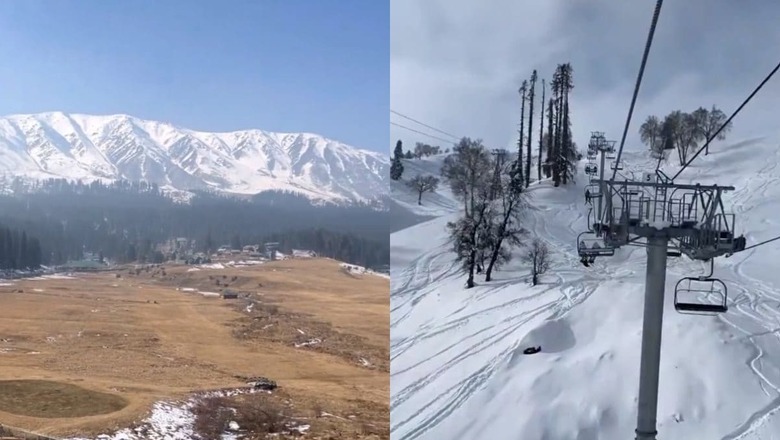
views
Gulmarg, one of the top tourist destinations in Kashmir famous for its ski resort, is facing an unprecedented dry spell this year. The Kashmiri ski resort, which used to attract people for its ski slopes and scenic beauty of the Himalayan Mountains, looks barren devoid of any winter snow.
It is the first January in several years, that Gulmarg and Pahalgam, famous for their snowy landscapes, have seen no snow, leaving the tourists and people upset.
Weather experts as well as those who depend on tourism for livelihood have expressed concern over the prolonged dry spell.
Why is Gulmarg Famous?
Gulmarg, which translates into meadow of flowers, is an icon of Kashmir tourism. Located close to the Line of Control in the Pir Panjal Mountain range in Western Himalayas, it is a cup-shaped valley with virgin peaks, dry curry powder snow and vast meadows.
Gulmarg has attracted millions of tourists throughout its existence with the scenic beauty of the Himalayan Mountains in the back drop. In 2023, over 1.65 million tourists visited the meadow, the highest footfall.

It is also famous skiing resort globally, attracting hundreds of national and international skiers who travel to Kashmir for skiing adventures.
One of the main attractions in Gulmarg is the Gulmarg Gondola, the Highest Cable Car in the world. It is also famous for its igloo café, largest in the world and a glass igloo restaurant.
Why is Kashmiri Ski Town Without Snow?
This year most of the resorts and Himalayan and Pirpanjal mountains across Jammu and Kashmir have little or no snow. As per meteorologists, the plains have received no snowfall while the hilly areas have seen below-average snowfall, contributing to a 79 per cent rainfall deficit throughout December in the Kashmir Valley.
The weather is likely to remain dry across Kashmir until January 20, when the crucial time for snow accumulation and glacier formation in the mountains may well be over. As per experts, the reduction in snowfall might lead to water scarcity and a potential food crisis in the region.
Gulmarg today pic.twitter.com/D4buxNSAEm— Weatherman Shubham (@shubhamtorres09) January 8, 2024
“The whole of December and the first week of January has been dry. There are no major precipitation chances in the coming days. The weather may remain dry till noon of January 16. There was a pattern of early snowfall for the last three to four years, which is missing this year,” Mukhtar Ahmad, the Director of the Kashmir Meteorological Centre, told ANI.
Last year, the valley received snowfall on December 30 and 31, 2022, and on January 4, 2023. Apart from Gulmarg, other tourist resorts like Pahalgam in South Kashmir and Sonamarg in Central Kashmir have also been without any winter snow.
There is also fear that the lack of snow might affect the skiing trips of adventure tourists and winter sports including the National winter games being held between February 2 and 6.
What is Behind the Inadequate Snow?
The unusual weather pattern has been attributed to the El Niño effect, characterised by the warming of sea surface temperatures in the Pacific Ocean, which disrupts global weather patterns.
El Nino is a climatic pattern that refers to the unusual warming of surface waters in the eastern tropical Pacific Ocean, constituting the “warm phase” of naturally occurring weather cycle called the El Nino-Southern Oscillation (ENSO).
This tourist is trying whatever option is available in Gulmarg nowadays -skiing on snow is normal but skiing on ice is not everybody’s cup of tea .#Gulmarg pic.twitter.com/M2dK2HrEGM— Farhat Naik (@Farhat_naik_) January 4, 2024
During an El Niño event, the surface of the tropical Pacific Ocean gets warmer than usual, particularly at the equator and along the coasts of South and Central America.
The warming triggers a shift in atmospheric circulation, resulting in reduced rainfall over Indonesia, India and northern Australia, while enhancing rainfall and tropical cyclone formation over the tropical Pacific Ocean.
Due to the ongoing effects of El Niño and other local factors, the India Meteorological Department (IMD) had predicted above-normal minimum and maximum temperatures for the December-February period.
While in Kashmir, El Nino’s impact is evident through prolonged dry spells, milder winters and diminished snowfall. Therefore, most parts of the country are expected to have a less harsh winter this year.
Meanwhile, experts have cautioned that the region is likely to face more frequent and extended droughts in the future.



















Comments
0 comment